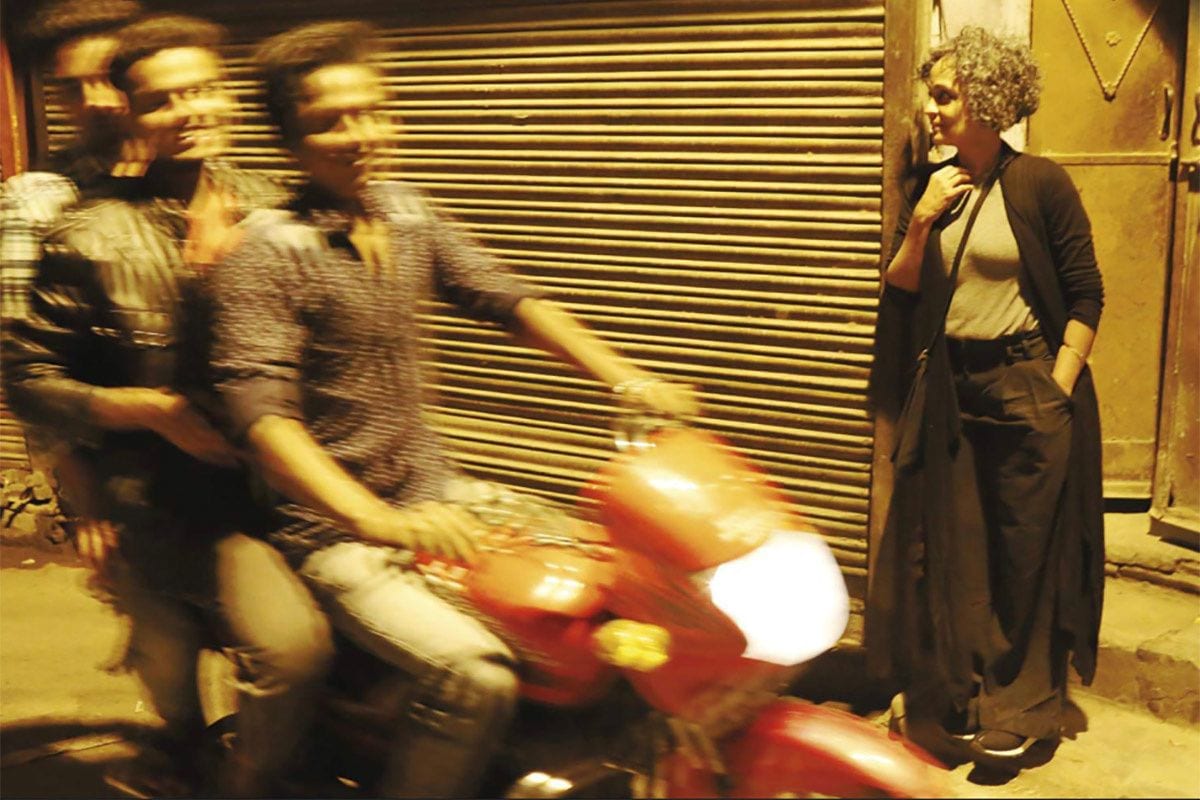
The strengths of a great essayist can often be found through their powers first seen in other forms. Novelist Arundhati Roy, one of the leading stars in the galaxy of Indian writers, won the Booker Prize in 1997 for her debut novel The God of Small Things. It was a powerful, evocative, and erotically charged look at the childhood experiences of fraternal twins who find their nation’s “love laws” restricting. It shifted times (between 1969 and 1993) and went through several generations as it commented on the eternal class divisions that have been a hallmark of India’s life as a country (since 1947).
What marks Roy’s admirable bravery and persistence as a writer is what happened next. Nine months after receiving the Booker Prize, almost as if she’d waited for the full gestation of her true literary powers, she published “The End of Imagination”. This essay opens My Seditious Heart: Collected Nonfiction, a carefully calibrated anthology of nonfiction. These works are published over the 20 years that came between her debut novel and her 2017’s follow-up, The Ministry of Utmost Happiness. Those novels evoked romance, longing, forbidden love, and class struggle with the grace of a writer working within the grand literary tradition of her country. (Expatriate Salman Rushdie and Pakistani Hanif Kureishi are but two of her peers). Her nonfiction, however (up to now available in 18 titles of varying lengths) proved more incendiary, more seditious (as her title might suggest.)
What happened? Why was this writer questioning the policies of her country as it took its steps towards becoming a superpower? She asks why India’s leaders are so eager to embrace the potential of the nuclear bomb, early in “The End of Imagination:”
“What do you do with these levels of lunacy? What do you do if you’re trapped in an asylum and the doctors are all dangerously deranged?”
There seems to be good reason Roy opens with this essay. It’s a personal story. She exploded onto the literary scene only months before India’s arrival as a player in the world of Nuclear bombs as weapons of defense (or offense). She writes, “The more I thought about it, the clearer it became to me that if fame was going to be my permanent condition it would kill me.” Roy recalls that she was an “item” being displayed by India in late 1997 as part of its end-of-the-year National Pride Parade, along with the bomb. Protesting the bomb was considered anti-Hindu. Roy concludes that India’s nuclear bomb “…is the final act of betrayal by a ruling class that has failed its people.”
Light bulb by ColiNOOB (Pixabay License / Pixabay)
The reader familiar with the cultural history of India as an independent country (which must include its time under British colonial rule) and the continued divisiveness of its class divisions through the caste system (where elements of the population are considered literally and figuratively “untouchable”) will find a great deal to embrace in this book. There’s a great deal of strength here for those interested in compelling political commentary. Roy takes things very personally, and while that might be a detriment in some essayists, she makes it a strength here. In her Foreword, she reflects on how she sees these essays, especially from the vantage point of so many years later:
“I find myself thinking of the essays in this book as pieces of laundry- poor people’s washing- strung out across the landscape between these two monuments, interrupting the good news bulletins and spoiling the view.”
In this respect, Royis in partnership with polemicists like Christopher Hitchens, whose work is less creative nonfiction personal navel-gazing and much more incendiary. Roy embraces the role of a seditionist, somebody upsetting the status quo in service of the greater good. Take these lines from the end of the first essay:
“The nuclear bomb is the most antidemocratic…outright evil thing that man has ever made. If you are religious, then remember that this bomb is Man’s challenge to God.”
The reader interested in such topics as India’s fondness for big dams, or the consequences of Hindu supremacists in India (pogroms, divided communities), sympathy for Maoists, and feminism in a country still not eager to embrace the full humanity of its women, will find much to embrace here. Coming in at 1,000 pages, with 45 essays, a glossary (essential for those unfamiliar with some Hindi language terminology), and extensive notes, effectively places this book within the comfortable yet sometimes shaky intersections between the literary, academic, and politically ideological.
Roy gets very deep into environmental issues, Kashmir separatist history, and the suffering of displaced tribes. Roy’s tendency to condemn might veer into hectoring and (as a result) prove tiresome, but it works for those with patience. Still, there is a tendency on Roy’s part to romanticize primitive eras. Of displaced tribes, she writes:
“…they had no money, but they were insured. If the rains failed, they had the forests to turn to. The river to fish in. Their livestock was their fixed deposit.”
In “Democracy: Who is She When She’s at Home?”, Roy goes around in circles for a while as she describes how political parties treat Indian democracy. Their marrow is tilled, mined, and tunneled under “…like termites excavating a mound.” Some of the essays face problems mainly because data provided to prove a point at the time will invariably change. For example, in 2005 nearly 800 million Indians lived on less than 20 rupees (about 30 cents) a day. Roy was using the same data in 2011, though government data indicated that the number had decreased to nearly 270 million. Failure on Roy’s part to update or revise some of these essays, or simply omit them in favor of stronger pieces, weighs down the ultimate effectiveness of this book.
In spite of these issues, it’s the more decisive and timeless reflections that make My Seditious Heart a compelling and important collection of socio-political essays. Take “The Algebra of Infinite Justice”, published 29 September 2001, in the midst of the numbing early weeks after 9/11. She writes of the US immediate reaction:
“What we’re witnessing here is the spectacle of the world’s most powerful country reacting reflectively, angrily, for an old instinct to fight a new kind of war.”
Back to issues of her own country, in “The Ladies have feelings, so shall we leave it to the experts?” she writes: “India lives in several centuries at the same time.” What is the role of the female writer/activist? She concludes (after reflecting on the seemingly eternal poverty in her country) that “…the only thing worth globalizing is dissent. It’s India’s best export.” In a defense (“On Citizen’s Rights to express dissent”), written after being held in criminal contempt for organizing and participating in a protest on the steps of India’s Supreme Court against the construction of a dam, Roy writes simply about her rights as a citizen. She shares obligation to speak up as a concerned person, as a writer, as an activist. In “Come September”, a lecture presented shortly after the first anniversary of 9/11, she reflects on testifying:
“There can never be a single story. There are only ways of seeing. So when I tell a story, I tell it not as an ideologue who wants to pit one absolutist ideology against another but as a storyteller who wants to share her way of seeing.”
It’s an interesting essay that asks rhetorically (a common literary device Roy uses), how many Septembers will we be suffering from isolated atrocities? “For how many Septembers…have millions of Asian people been bombed, burned, and slaughtered?” She cites the tragic connections of the date 9/11 in the Middle East, a mandate from the British government in 1922 that paved the way for a Jewish state denying full human rights for Palestinians:
“In 1969 Israeli Prime Minister Golda Meier said, ‘Palestinians do not exist.'”
In “The Loneliness of Noam Chomsky”, written as an introduction to a book of essays by the like-minded writer, Roy writes: “Chomsky shows us how phrases like free speech, the free market, and the free world have little, if anything, to do with freedom.” It’s a good way to look at where Roy saw herself then, and perhaps still sees herself. She’s gone from literary darling in 1997 to proud dissenter/rabble-rouser. In this book’s title 2016 essay, Roy writes about untouchables, about class struggle, about a country (India) still denying past transgressions on its road towards power, all along still fighting with Kashmir separatists: “Our forests are full of soldiers and our universities full of police.” Later, she writes: “What we call ‘human civilization’ is just a few thousand years old. India as a country with its present borders is less than 80 years old. Clearly, we could do with a little perspective.”
The strongest essays in this collection include “Walking With the Comrades”, a 2010 narrative in which Roy recounts several weeks she spent traveling with a group of Maoists in central India forests. While the Indian Prime Minister viewed the Maoists as the most dangerous threat to the stability of his country, Roy saw them as survivors of many generations of dispossession. Roy carefully details show trials the Maoists held before executing their police prisoners. “How can we accept them? Or approve of this form of justice?” She asks and answers her question by rationalizing the acts of the Maoists because they were in touch with ordinary life. It’s a disputable conclusion, but the writing is strong and heartfelt and in keeping with Roy’s willingness to stand up for the disenfranchised. The strength of the writing overrides any conclusions we might make about the writer’s character.
My Seditious Heart ends with an Appendix featuring two 1994 essays (“The Great Indian Rape-Trick I” and “II”) about Shekhar Kapur’s 1994 film, The Bandit Queen, in which the brutal violation of Phoolan Devi was portrayed. Roy accuses the filmmakers of “recreating her [Devi’s] degradation for public consumption…without her consent.” Roy makes it perfectly clear how she feels about the film’s motivation: “Rape is the main dish. Caste is the sauce that it swims in.”
Roy puts herself on the line defending how unfairly the fate of this woman was portrayed. It’s the way that low-caste Devi’s rape was portrayed in the film that proved most objectionable to Roy. Devi was released from prison around the time of the film’s release. She ran for and won political office, only to be assassinated in 2001 at the age of 37. She’d denied having murdered 22 people, but the film makes it clear she did. It’s her treatment that Roy objects to:
“In their quest for Classic Cinema, they’ve stripped a human being of her Rights. Her Dignity. Her Privacy. Her Freedom.”
The strengths of the tone and approach in these essays are many, but the reader encountering them here for the first time see more clearly the problems in her nonfiction. Roy tends to be didactic, and quick to condemn. The more personal approaches, the essays in which we see her in the world of her subjects, are compelling. The ones that feel like policy papers and preaching to the choir (“An Ordinary Person’s Guide to Empire”, “How Deep Shall We Dig?”) weigh this book down more than Roy may have wanted.
While My Seditious Heart is a mixed bag, its strengths shine brightly. This book conclusively serves notice that Arundhati Roy is an heir apparent to the greatest social essayists, from William Hazzlitt through Christopher Hitchens and more. One can only hope she is working on more essays about our current state of world affairs. Now more than ever, she is a writer we need, as she’ll help to put this complex mess of our times into a more understandable perspective.


